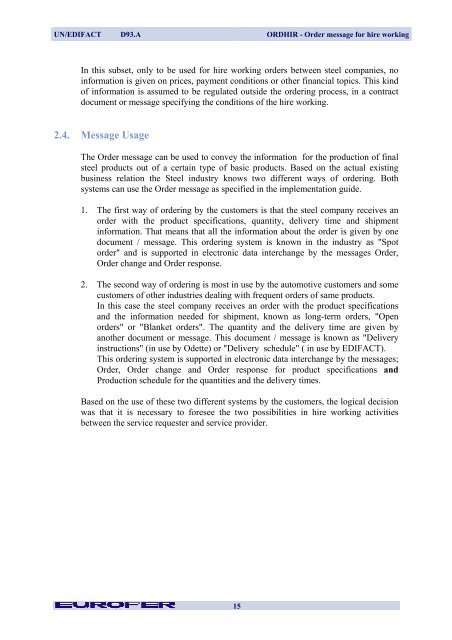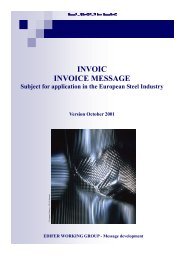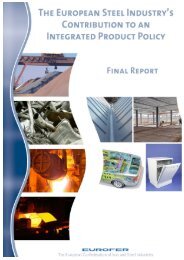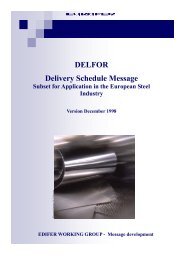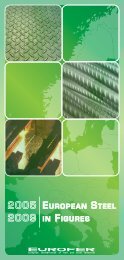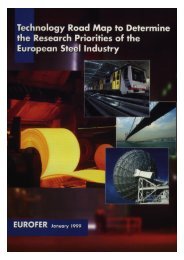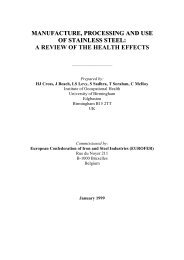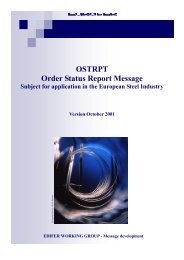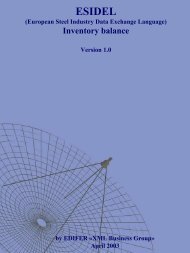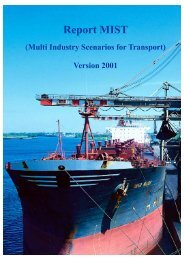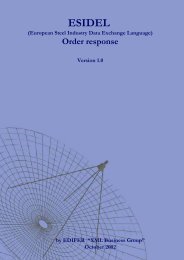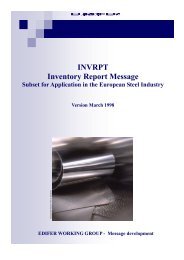ORDHIR Order Message for Hire Working - Eurofer
ORDHIR Order Message for Hire Working - Eurofer
ORDHIR Order Message for Hire Working - Eurofer
You also want an ePaper? Increase the reach of your titles
YUMPU automatically turns print PDFs into web optimized ePapers that Google loves.
UN/EDIFACT D93.A <strong>ORDHIR</strong> - <strong>Order</strong> message <strong>for</strong> hire working<br />
In this subset, only to be used <strong>for</strong> hire working orders between steel companies, no<br />
in<strong>for</strong>mation is given on prices, payment conditions or other financial topics. This kind<br />
of in<strong>for</strong>mation is assumed to be regulated outside the ordering process, in a contract<br />
document or message specifying the conditions of the hire working.<br />
2.4. <strong>Message</strong> Usage<br />
The <strong>Order</strong> message can be used to convey the in<strong>for</strong>mation <strong>for</strong> the production of final<br />
steel products out of a certain type of basic products. Based on the actual existing<br />
business relation the Steel industry knows two different ways of ordering. Both<br />
systems can use the <strong>Order</strong> message as specified in the implementation guide.<br />
1. The first way of ordering by the customers is that the steel company receives an<br />
order with the product specifications, quantity, delivery time and shipment<br />
in<strong>for</strong>mation. That means that all the in<strong>for</strong>mation about the order is given by one<br />
document / message. This ordering system is known in the industry as "Spot<br />
order" and is supported in electronic data interchange by the messages <strong>Order</strong>,<br />
<strong>Order</strong> change and <strong>Order</strong> response.<br />
2. The second way of ordering is most in use by the automotive customers and some<br />
customers of other industries dealing with frequent orders of same products.<br />
In this case the steel company receives an order with the product specifications<br />
and the in<strong>for</strong>mation needed <strong>for</strong> shipment, known as long-term orders, "Open<br />
orders" or "Blanket orders". The quantity and the delivery time are given by<br />
another document or message. This document / message is known as "Delivery<br />
instructions" (in use by Odette) or "Delivery schedule" ( in use by EDIFACT).<br />
This ordering system is supported in electronic data interchange by the messages;<br />
<strong>Order</strong>, <strong>Order</strong> change and <strong>Order</strong> response <strong>for</strong> product specifications and<br />
Production schedule <strong>for</strong> the quantities and the delivery times.<br />
Based on the use of these two different systems by the customers, the logical decision<br />
was that it is necessary to <strong>for</strong>esee the two possibilities in hire working activities<br />
between the service requester and service provider.<br />
15


